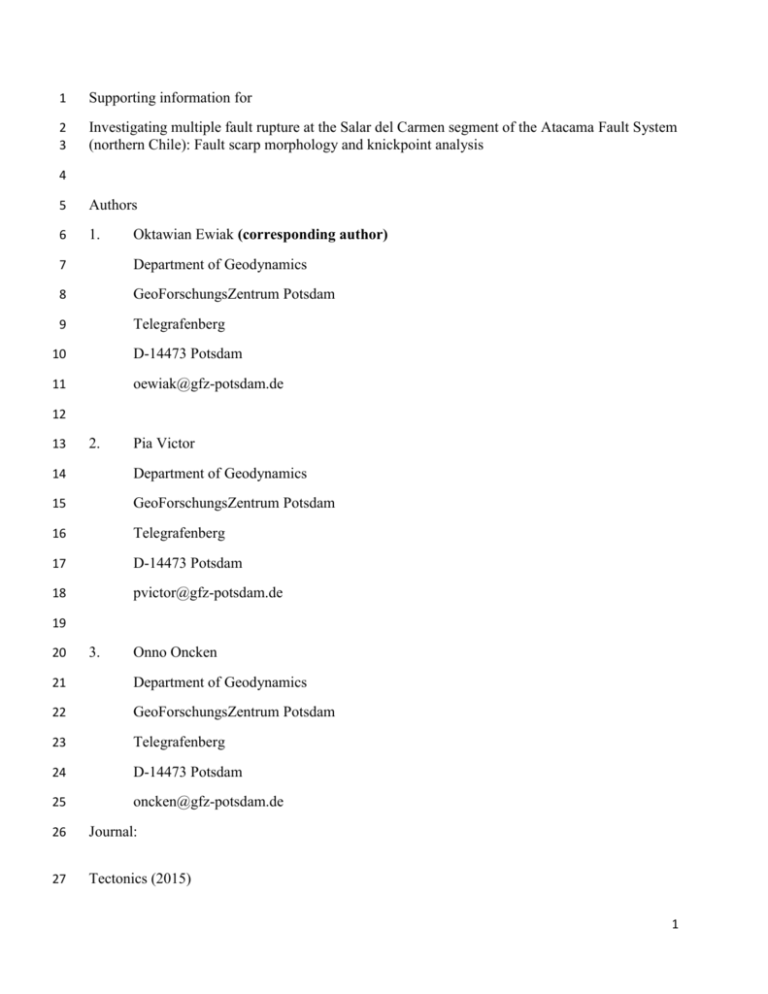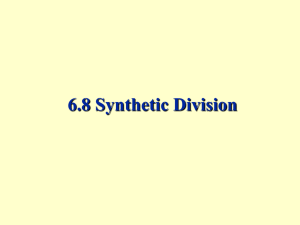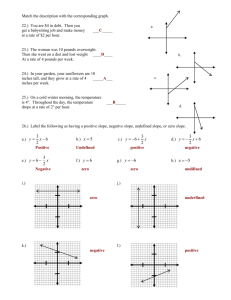tect20238-sup-0002-supplementary
advertisement

1 Supporting information for 2 3 Investigating multiple fault rupture at the Salar del Carmen segment of the Atacama Fault System (northern Chile): Fault scarp morphology and knickpoint analysis 4 5 Authors 6 1. Oktawian Ewiak (corresponding author) 7 Department of Geodynamics 8 GeoForschungsZentrum Potsdam 9 Telegrafenberg 10 D-14473 Potsdam 11 oewiak@gfz-potsdam.de 12 13 2. Pia Victor 14 Department of Geodynamics 15 GeoForschungsZentrum Potsdam 16 Telegrafenberg 17 D-14473 Potsdam 18 pvictor@gfz-potsdam.de 19 20 3. Onno Oncken 21 Department of Geodynamics 22 GeoForschungsZentrum Potsdam 23 Telegrafenberg 24 D-14473 Potsdam 25 oncken@gfz-potsdam.de 26 Journal: 27 Tectonics (2015) 1 28 Supporting information outline 29 1. Introduction 30 2. Sensitivity tests 31 3. Calculation of synthetic SRL 32 4. File descriptors and supplementary figure captions 33 34 35 36 37 38 39 40 41 42 43 44 45 46 2 47 1. Introduction 48 The supplementary material to this article contains two short text passages describing a) the 49 sensitivity tests carried out to examine the effects of varying parameters on the routine for 50 calculation of gradient along profile, and to estimate an age threshold up to which our approach 51 reliably detects breaks in slope in the analyzed profiles, and b) the calculation of synthetic rupture 52 lengths from previously derived paleomagnitudes. These descriptions are provided in the 53 paragraphs below. 54 55 2. Sensitivity tests 56 To examine the effects of varying parameters on the routine for calculation of gradient along 57 profile, and to estimate an age threshold up to which our approach reliably detects breaks in slope 58 in the analyzed profiles, we conducted a series of tests. For this purpose, we created synthetic 59 profiles with a length of 100 m. We varied the initial scarp height, the background slope angle α 60 and the initial maximum scarp slope angle θ using the Matlab code Scarp Diffusion Lab (SDL) 61 [Hilley and Arrowsmith, 2003]. Subsequently, we modeled the degradation at different time steps 62 using the forward modeling function in SDL. Modeling of scarp degradation is strongly 63 dependent on the diffusion constant κ. We have chosen two end member diffusion constants 64 (κ1 = 0.46 m²/ka, κ2 = 0.046 m²/ka) proposed as reasonable values for the hyperarid climate 65 environment of the N-Chilean Atacama desert by González and Carrizo [2003]. After forward 66 modeling of scarp degradation we exported the synthetic data and analyzed it using our sliding 67 window approach. 68 We have tested two initial maximum scarp slopes θ1 = 80° and θ2 = 60° with a background slope 69 α = 0° and initial scarp heights of 1 m and 3 m. Degradation was modeled for time steps of 500 a, 3 70 1 ka, 10 ka, 20 ka, 40 ka, 60 ka, 80 ka, and 100 ka using diffusion constants κ1 and κ2. 71 Subsequently, we calculated gradient along the synthetic profiles using window sizes between 3 72 and 25. The initial scarp height had no effect on the obtained results. Variation of window size 73 also had no significant impact on the detection of slope breaks, but still proved useful to decrease 74 noise in real data. Troughs in gradient data were recognizable over the whole range of modeled 75 ages (Figures S4 – S5), but profiles with model ages over 40 ka (κ1) only introduced minor 76 changes to the output as erosion acts strongest on steep surfaces. Using the lower diffusion 77 constant κ2 (κ2 = κ1 * 0.1) resulted in steeper troughs for higher ages (Figures S6 – S7). This 78 implies that erosion has a significant impact on our approach for detection of slope breaks. The 79 initial scarp slope angle θ influences the width of the troughs in gradient data. For very low initial 80 dip angles, e.g., 10°, the resulting gradient data would show broad valleys instead of steep 81 troughs due to the stability of gradient over distance. However, for realistic initial values 82 (θ1 = 80°, θ2 = 60°) gradient data shows prominent troughs (Figures S4 – S7). 83 In a subsequent test, we used profiles with an initial maximum scarp slope of 60°, but changed 84 the background slope α to 4°. All other parameters were kept the same. The gradient data shows 85 prominent troughs up to 60 ka for degradation based on constant κ1 for all window sizes 86 (Figure S8). Using κ2, gradient data displays prominent troughs for the entire range of tested ages 87 up to 100 ka (Figure S9). Thus, for an normal fault with a realistic dip angle of ~60°, our sliding 88 window approach is capable of reliably detecting slope breaks in fault scarp data over the entire 89 range of time steps. 90 Variation of window sizes was mainly used to improve the signal to noise ratio. Smoothing 91 increased with window size. We note that the output slope angle was observed to decrease with 92 increasing window size as the differentiation is carried out for an increasing amount of data 4 93 points. The most accurate measurement of slope angle is accomplished by using the smallest 94 window size. However, to derive the number of events recorded in profile data, we focused on 95 detecting breaks in gradient rather than measuring absolute slope angles. 96 97 3. Calculation of synthetic SRL 98 Synthetic SRL were calculated from paleomagnitudes (Figure S10; Table 1, equation (6)), which 99 were previously derived from (a) the LDI at the fault scarp and (b) displacement at knickpoints 100 (KnpD) to compare them with the mapped SRL in the study areas. SRL based on LDI range from 101 19.0 km to 34.2 km in the CJS, and from 12.9 km to 28.1 km in the LNS. SRL based on KnpD 102 range from 8.7 km to 23.8 km for the CJS, and from 7.7 km to 19.8 km for the LNS. The 103 synthetic SRL based on paleomagnitudes calculated from LDI and KnpD are in reasonable 104 agreement with the mapped total length of the CJS (19 km). In case of the LNS, all synthetic SRL 105 are larger than the mapped segment. Thus, for large earthquakes with Mw ~ 7, we assume an 106 involvement of adjacent segments. 107 108 109 110 111 112 5 113 4. File descriptors and supplementary figure captions 114 Filename: tect20238-sup-0003-pS01.tif 115 File descriptor: Aerial view of CJS 116 Figure S1: Aerial view of the area depicted in Figure 2a. Aerial photographs were acquired with 117 the Modular Airborne Camera System, developed by the DLR (German Aerospace Center; 118 Lehmann et al., 2011; Bucher et al., 2012). 119 120 Filename: tect20238-sup-0004-pS02.tif 121 File descriptor: Aerial view of LNS 122 Figure S2: Aerial view of the area depicted in Figure 3a. Aerial photographs were acquired with 123 the Modular Airborne Camera System, developed by the DLR (German Aerospace Center; 124 Lehmann et al., 2011; Bucher et al., 2012). 125 126 Filename: tect20238-sup-0005-pS03.tif 127 File descriptor: Profiles of selected channels 128 Figure S3: Longitudinal and cross-sectional profiles of selected channels. a) Longitudinal profiles 129 (A, B, C) of three selected main channels in the La Negra segment. The vertical line marks the 130 intersection with the surface rupture. The profiles do not contain any knickpoints related to the 131 analyzed surface rupture. b) Cross-sectional profiles of the channels in panel a). Cross-sections 132 have been extracted at the surface rupture. Channel widths have been measured across the most 6 133 deeply incised sections of the channels. c) Longitudinal profiles (D, E, F) of three gullies from 134 the Cumbre Jequier segment. Knickpoints related to the analyzed surface rupture are marked with 135 circles. d) Cross-sectional profiles of the gullies in panel c). Cross-sections have been extracted at 136 the surface rupture. Channel widths have been measured across the most deeply incised sections 137 of the channels. 138 139 Filename: tect20238-sup-0006-pS04.tif 140 File descriptor: Synthetic profiles 141 Figure S4: Synthetic profiles generated with SDL [Hilley and Arrowsmith, 2003]. Initial scarp 142 slope angle θ1 = 80°, data point spacing d = 0.1 m, background slope angle α = 0°. Consecutive 143 time steps from 0 a to 100 ka are marked with different colors. Diffusion constant for degradation 144 forward modeling κ1 = 0.46 m²/ka. a) Synthetic profile data. b) Calculated gradient data, window 145 size = 3. Inset shows zoom between -10 and +10 m. c) Calculated gradient data, window 146 size = 25. Inset shows zoom between -10 and +10 m. 147 148 Filename: tect20238-sup-0007-pS05.tif 149 File descriptor: Synthetic profiles 150 Figure S5: Synthetic profiles generated with SDL [Hilley and Arrowsmith, 2003]. Initial scarp 151 slope angle θ2 = 60°, data point spacing d = 0.1 m, background slope angle α = 0°. Consecutive 152 time steps from 0 a to 100 ka are marked with different colors. Diffusion constant for degradation 153 forward modeling κ1 = 0.46 m²/ka. a) Synthetic profile data. Inset shows zoom between -20 and 7 154 +10 m. b) Calculated gradient data, window size = 3. Inset shows zoom between -10 and +10 m. 155 c) Calculated gradient data, window size = 25. Inset shows zoom between -10 and +10 m. 156 157 Filename: tect20238-sup-0008-pS06.tif 158 File descriptor: Synthetic profiles 159 Figure S6: Synthetic profiles generated with SDL [Hilley and Arrowsmith, 2003]. Initial scarp 160 slope angle θ1 = 80°, data point spacing d = 0.1 m, background slope angle α = 0°. Consecutive 161 time steps from 0 a to 100 ka are marked with different colors. Diffusion constant for degradation 162 forward modeling κ2 = 0.046 m²/ka. a) Synthetic profile data. b) Calculated gradient data, 163 window size = 3. Inset shows zoom between -10 and +10 m. c) Calculated gradient data, window 164 size = 25. Inset shows zoom between -10 and +10 m. 165 166 Filename: tect20238-sup-0009-pS07.tif 167 File descriptor: Synthetic profiles 168 Figure S7: Synthetic profiles generated with SDL [Hilley and Arrowsmith, 2003]. Initial scarp 169 slope angle θ2 = 60°, data point spacing d = 0.1 m, background slope angle α = 0°. Consecutive 170 time steps from 0 a to 100 ka are marked with different colors. Diffusion constant for degradation 171 forward modeling κ2 = 0.046 m²/ka. a) Synthetic profile data. Inset shows zoom between -20 and 172 10 m. b) Calculated gradient data, window size = 3. Inset shows zoom between -10 and +10 m. 173 c) Calculated gradient data, window size = 25. Inset shows zoom between -10 and +10 m. 174 8 175 Filename: tect20238-sup-0010-pS08.tif 176 File descriptor: Synthetic profiles 177 Figure S8: Synthetic profiles generated with SDL [Hilley and Arrowsmith, 2003]. Initial scarp 178 slope angle θ2 = 60°, data point spacing d = 0.1 m, background slope angle α = 4°. Consecutive 179 time steps from 0 a to 100 ka are marked with different colors. Diffusion constant for degradation 180 forward modeling κ1 = 0.46 m²/ka. a) Synthetic profile data. Inset shows zoom between -20 and 181 5 m. b) Calculated gradient data, window size = 3. Inset shows zoom between -20 and +20 m. 182 c) Calculated gradient data, window size = 25. Inset shows zoom between -20 and +20 m. 183 184 Filename: tect20238-sup-0011-pS09.tif 185 File descriptor: Synthetic profiles 186 Figure S9: Synthetic profiles generated with SDL [Hilley and Arrowsmith, 2003]. Initial scarp 187 slope angle θ2 = 60°, data point spacing d = 0.1 m, background slope angle α = 4°. Consecutive 188 time steps from 0 a to 100 ka are marked with different colors. Diffusion constant for degradation 189 forward modeling κ2 = 0.046 m²/ka. a) Synthetic profile data. Inset shows zoom between -20 and 190 5 m. b) Calculated gradient data, window size = 3. Inset shows zoom between -15 and +15 m. 191 c) Calculated gradient data, window size = 25. Inset shows zoom between -15 and +15 m. 192 193 Filename: tect20238-sup-0012-pS10.tif 194 File descriptor: Synthetic SRL from moment magnitude (Mw) 9 195 Figure S10: Synthetic SRL calculated from moment magnitude (Mw) using the regression 196 function (Table 1, equation (6)) by Wells and Coppersmith [1994]. Magnitudes used for 197 calculation of SRL have been previously determined based on measured displacement (LDI, and 198 KnpD). The hatched boxes mark the range of magnitudes and the resulting synthetic SRL. 10






